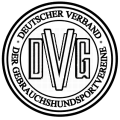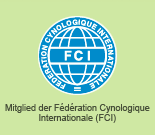Name: Australian Kelpie
Ursprungsland: Australien
Standardnummer: 293
Widerristhöhe: Rüden: 46-51 cm, Hündinnen: 43-48 cm
Gewicht: bis 22 kg
Verwendung: Schäferhund
FCI-Gruppe 1: mit Arbeitsprüfung
Beschreibung
Geschichte
Haarkleid
Quelle: VDH (Rasselexikon)
Australian Kelpie
|
Group: |
Group 5 (Working Dogs) |
| History: | Link |
| General Appearance: | The general appearance shall be that of a lithe, active dog of great quality, showing hard muscular condition combined with great suppleness of limb and conveying the capability of untiring work. It must be free from any suggestion of weediness. |
| Characteristics: | The Kelpie is extremely alert, eager and highly intelligent, with a mild, tractable disposition and an almost inexhaustible energy, with marked loyalty and devotion to duty. It has a natural instinct and aptitude in the working of sheep, both in open country and in the yard. Any defect of structure or temperament foreign to a working dog must be regarded as uncharacteristic. |
| Temperament: | (See under characteristics) |
| Head And Skull: | The head is in proportion to the size of the dog, the skull slightly rounded, and broad between the ears. The forehead running in a straight profile towards a pronounced stop. The cheeks are neither coarse nor prominent, but round to the foreface, which is cleanly chiselled and defined. The muzzle, preferably slightly shorter in length than the skull. Lips tight and clean and free from looseness. The nose colouring conforms to that of the body coat. The overall shape and contours produce a rather fox-like expression, which is softened by the almond-shaped eyes. |
| Eyes: | The eyes are almond shaped, of medium size, clearly defined at the corners, and show an intelligent and eager expression. The colour of the eyes to be brown, harmonising with the colour of the coat. In the case of blue dogs a lighter coloured eye is permissible. |
| Ears: | The ears are pricked and running to a fine point at the tips, the leather fine but strong at the base, set wide apart on the skull and inclining outwards, slightly curved on the outer edge and of moderate size. The inside of the ears is well furnished with hair. |
| Mouth: | The teeth should be sound, strong and evenly spaced, the lower incisors just behind but touching the upper, that is a scissor bite. |
| Neck: | The neck is of moderate length, strong, slightly arched, gradually moulding into the shoulders, free from throatiness and showing a fair amount of ruff. |
| Forequarters: | The shoulders should be clean, muscular, well sloping with the shoulder blades close set at the withers. The upper arm should be at a right angle with the shoulder blade. Elbows neither in nor out. The forelegs should be muscular with strong but refined bone, straight and parallel when viewed from the front. When viewed from the side, the pasterns should show a slight slope to ensure flexibility of movement and the ability to turn quickly. |
| Body: | The ribs are well sprung and the chest must be deep rather than wide, with a firm level topline, strong and well-muscled loins and good depth of flank. The length of the dog from the forechest in a straight line to the buttocks, is greater than the height at the withers as 10 is to 9. |
| Hindquarters: | The hindquarters should show breadth and strength, with the croup rather long and sloping, the stifles well turned and the hocks fairly well let down. When viewed from behind, the hind legs, from the hocks to the feet, are straight and placed parallel, neither close nor too wide apart. |
| Feet: | The feet should be round, strong, deep in pads, with close knit, well arched toes and strong short nails. |
| Tail: | The tail during rest should hang in a very slight curve. During movement or excitement it may be raised, but under no circumstances should the tail be carried past a vertical line drawn through the root. It should be furnished with a good brush. Set on position to blend with sloping croup, and it should reach approximately to the hock. |
| Gait/Movement: | To produce the almost limitless stamina demanded of a working sheepdog in wide open spaces the Kelpie must be perfectly sound, both in construction and movement. Any tendency to cow hocks, bow hocks, stiltiness, loose shoulders or restricted movement weaving or plaiting is a serious fault. Movement should be free and tireless and the dog must have the ability to turn suddenly at speed. When trotting the feet tend to come closer together at ground level as speed increases but when the dog comes to rest it stands four square. |
| Coat: | The coat is a double coat with a short dense undercoat. The outercoat is close, each hair straight, hard, and lying flat, so that it is rain-resisting. Under the body, to behind the legs, the coat is longer and forms near the thigh a mild form of breeching. On the head (including the inside of the ears), to the front of the legs and feet, the hair is short. Along the neck it is longer and thicker forming a ruff. The tail should be furnished with a good brush. A coat either too long or too short is a fault. As an average, the hairs on the body should be from 2 to 3 cms (approx. 0.75 - 1.25 ins) in length. |
| Colour: | Black, black and tan, red, red and tan, fawn, chocolate, and smoke blue. |
| Sizes: | Height: Dogs 46-51 cms (approx. 18-20 ins) at withers Bitches 43-48 cms (approx. 17-19 ins) at withers |
| Faults: | Any departure from the foregoing points should be considered a fault and the seriousness with which the fault should be regarded should be in exact proportion to its degree and its effect upon the health and welfare of the dog. |
| Notes: | Male animals should have two apparently normal testicles fully descended into the scrotum. |
(taken from: ANKC Ltd)




